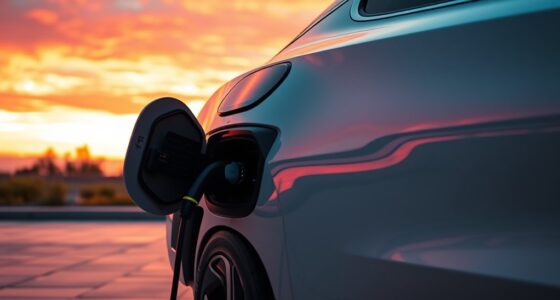New car prices in 2025 are expected to stay high due to ongoing supply chain disruptions and material shortages. The pandemic has exposed vulnerabilities in production, leading to delays and increased costs. Additionally, the rising demand for electric vehicles adds pressure to an already strained supply chain, as EV manufacturing relies on expensive materials. If you’re curious about how these factors will evolve and affect your next car purchase, there’s more to uncover.
Key Takeaways
- Supply chain disruptions from the pandemic have led to increased manufacturing costs and delays in vehicle production.
- High demand for both traditional and electric vehicles continues to outpace supply, driving prices upward.
- Scarcity of materials, especially for electric vehicle batteries, contributes to higher production costs and vehicle prices.
- Advanced technologies in vehicles add significant costs, as automakers invest in safety and connectivity features.
- Economic factors like inflation and interest rates further influence the pricing landscape for new cars in 2025.

Have you ever wondered how much new cars will cost in 2025? The answer isn’t straightforward, but it’s likely that prices will still be high. Factors such as inflation, evolving technologies, and ongoing supply chain disruptions play vital roles in shaping the market. As you consider your options for a new vehicle, it’s important to understand these influences.
The rise of electric vehicles (EVs) is a significant trend driving new car prices. You might be excited about the benefits of going green, but the reality is that producing these cars often involves costly materials and technologies. Batteries, for instance, are a major expense, and as demand for EVs increases, so does pressure on the supply chain. If you’re hoping to buy a new EV in 2025, expect to pay a premium, especially if certain materials become scarce.
Supply chain disruptions have been a hot topic in recent years, and they’re not going away anytime soon. The pandemic exposed vulnerabilities in production and logistics, leading to delays and increased costs for manufacturers. If you’ve noticed empty lots at dealerships and long wait times for new cars, you’re not alone. Automakers have struggled to keep up with demand, and this imbalance has inflated prices. By 2025, you may find that high demand for both traditional and electric vehicles continues to outpace supply, leading to higher costs.
Another factor impacting new car prices is the shift toward advanced technologies. As automakers invest in features like autonomous driving, enhanced safety systems, and smart connectivity, these innovations come with a price tag. You might appreciate the added safety and convenience, but these features also contribute to the overall cost of new vehicles. If you’re considering a tech-savvy car in 2025, prepare for a steep investment.
Finally, the broader economic landscape will also affect new car prices. Factors like interest rates, inflation, and consumer spending habits will play a role in setting prices. If you’re eyeing a new vehicle in 2025, staying informed about economic trends will help you make a more educated decision. Additionally, high demand for electric vehicles may further exacerbate price increases due to limited supply.
Frequently Asked Questions
How Do Electric Vehicle Trends Impact New Car Prices?
Electric vehicle trends substantially impact new car prices. As battery costs rise due to demand, manufacturers often pass those expenses onto consumers. You’ll notice that the increasing focus on developing charging infrastructure also plays a role; it influences the overall market appeal and availability of EVs. As more consumers shift towards electric vehicles, traditional car prices can fluctuate, reflecting the evolving landscape of the automotive industry.
What Is the Role of Government Regulations in Pricing?
Government regulations play a vital role in pricing, with compliance costs affecting what you pay. Did you know that nearly 20% of a car’s price can come from meeting regulatory standards? Safety mandates, like those for airbags and crash tests, add to manufacturing expenses, which automakers often pass on to you. While these regulations aim to keep you safe, they also contribute considerably to the overall cost of new vehicles.
Are Used Car Prices Also Affected by These Supply Chain Issues?
Yes, used car prices are affected by supply chain issues. When new car production slows, more people turn to the resale market, driving up demand for used vehicles. This increased demand leads to used car inflation, pushing prices higher. You might notice this trend when shopping for a car. As fewer new models hit the market, the competition for quality used cars intensifies, making them pricier than you’d expect.
How Do Trade Policies Influence Car Prices in 2025?
Trade policies, including trade tariffs and import restrictions, profoundly influence car prices in 2025. When tariffs increase, manufacturers often pass those costs onto consumers, raising prices. Import restrictions limit the availability of certain vehicles, which can create shortages and drive prices even higher. If you’re looking to buy, these policies can directly impact your budget, making it essential to stay informed about how they shift the market landscape.
What Can Consumers Do to Mitigate High Car Prices?
To mitigate high car prices, explore various financing options that suit your budget. Look for low-interest loans or special dealership promotions. Don’t hesitate to negotiate the price—dealers often expect it. Research the vehicle’s market value beforehand to strengthen your position. Additionally, consider buying used or certified pre-owned vehicles to save money. Staying informed and flexible can help you secure a better deal and make your purchase more affordable.
Conclusion
Despite the allure of new car ownership, soaring prices in 2025 reflect a complex web of supply chain disruptions and material shortages. While the dream of driving a brand-new vehicle remains, the reality of inflated costs weighs heavily on your wallet. It’s a stark contrast: the excitement of innovation clashes with the frustration of scarcity. As you navigate this landscape, understanding the underlying factors can help you make informed choices, balancing desire with practicality in your automotive journey.










